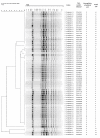Genetic diversity of Salmonella enteric serovar typhi and paratyphi in Shenzhen, China from 2002 through 2007
- PMID: 20113512
- PMCID: PMC2824697
- DOI: 10.1186/1471-2180-10-32
Genetic diversity of Salmonella enteric serovar typhi and paratyphi in Shenzhen, China from 2002 through 2007
Abstract
Background: Typhoid and paratyphoid fever are endemic in China. The objective of this investigation was to determine the molecular features of nalidixic acid-resistant Salmonella enteric serovar Typhi (S. typhi) and Paratyphi (S. paratyphi) from blood isolates in Shenzhen, China.
Results: Twenty-five S. typhi and 66 S. paratyphi were isolated from 91 bacteremic patients between 2002 and 2007 at a hospital in Shenzhen, Southern China. Fifty-two percent (13/25) of S. typhi and 95.3% (61/64) of S. paratyphi A were resistant to nalidixic acid. Sixty-seven isolates of nalidixic acid-resistant Salmonella (NARS) showed decreased susceptibility to ciprofloxacin (MICs of 0.125-1 microg/mL). All 75 NARS isolates had a single substitution in the quinolone resistance-determining region (QRDR) of GyrA (Ser83-->Phe/Pro/Tyr, or Asp87-->Gly/Asn), and 90.7% of these isolates carried the substitution Ser83Phe in GyrA. No mutation was found in the QRDR of gyrB, parC, or parE. Plasmid mediated quinolone resistance genes including qnr and aac(6')-Ib-cr were not detected in any isolate. Twenty-two distinct pulsed field gel electrophoresis (PFGE) patterns were observed among S. typhi. Sixty-four isolates of S. paratyphi A belonged to one clone. Eighty-seven investigated inpatients were infected in the community. Six patients infected by S. paratyphi A had a travel history before infection.
Conclusions: Nalidixic acid-resistant S. typhi and S. paratyphi A blood isolates were highly prevalent in Shenzhen, China. PFGE showed the variable genetic diversity of nalidixic acid-resistant S. typhi and limited genetic diversity of nalidixic acid -resistant S. paratyphi A.
Figures



Similar articles
-
Molecular characterization of ciprofloxacin-resistant Salmonella enterica serovar Typhi and Paratyphi A causing enteric fever in India.J Antimicrob Chemother. 2006 Dec;58(6):1139-44. doi: 10.1093/jac/dkl391. Epub 2006 Oct 28. J Antimicrob Chemother. 2006. PMID: 17071955
-
Reduced susceptibility to ciprofloxacin and gyra gene mutation in North Indian strains of Salmonella enterica serotype Typhi and serotype Paratyphi A.Microb Drug Resist. 2004 Summer;10(2):146-53. doi: 10.1089/1076629041310028. Microb Drug Resist. 2004. PMID: 15256030
-
Genomic epidemiology and antimicrobial resistance reveal local transmission dynamics of enteric fever in Shenzhen, one of the mega cities in China.J Infect. 2025 Apr;90(4):106469. doi: 10.1016/j.jinf.2025.106469. Epub 2025 Mar 7. J Infect. 2025. PMID: 40058502
-
Enteric fever: a travel medicine oriented view.Curr Opin Infect Dis. 2010 Oct;23(5):432-7. doi: 10.1097/QCO.0b013e32833c7ca1. Curr Opin Infect Dis. 2010. PMID: 20613510 Review.
-
Drug-resistant enteric fever worldwide, 1990 to 2018: a systematic review and meta-analysis.BMC Med. 2020 Jan 3;18(1):1. doi: 10.1186/s12916-019-1443-1. BMC Med. 2020. PMID: 31898501 Free PMC article.
Cited by
-
Prevalence of Antimicrobial Resistance Genes in Salmonella Typhi: A Systematic Review and Meta-Analysis.Trop Med Infect Dis. 2022 Sep 27;7(10):271. doi: 10.3390/tropicalmed7100271. Trop Med Infect Dis. 2022. PMID: 36288012 Free PMC article. Review.
-
Paratyphoid fever: splicing the global analyses.Int J Med Sci. 2014 May 14;11(7):732-41. doi: 10.7150/ijms.7768. eCollection 2014. Int J Med Sci. 2014. PMID: 24904229 Free PMC article. Review.
-
Genotyping of Salmonella enterica serovar Typhi strains isolated from 1959 to 2006 in China and analysis of genetic diversity by genomic microarray.Croat Med J. 2011 Dec 15;52(6):688-93. doi: 10.3325/cmj.2011.52.688. Croat Med J. 2011. PMID: 22180267 Free PMC article.
-
Sensitivity Pattern Of Salmonella typhi And Paratyphi A Isolates To Chloramphenicol And Other Anti-Typhoid Drugs: An In Vitro Study.Infect Drug Resist. 2019 Oct 14;12:3217-3225. doi: 10.2147/IDR.S204618. eCollection 2019. Infect Drug Resist. 2019. PMID: 31686872 Free PMC article.
-
Genomic analyses of multidrug-resistant Salmonella Indiana, Typhimurium, and Enteritidis isolates using MinION and MiSeq sequencing technologies.PLoS One. 2020 Jul 2;15(7):e0235641. doi: 10.1371/journal.pone.0235641. eCollection 2020. PLoS One. 2020. PMID: 32614888 Free PMC article.
References
-
- Clinical and Laboratory Standards Institute. Approved standard M7-A7. 7. Clinical and Laboratory Standards Institute, Wayne, PA; 2006. Methods for dilution antimicrobial susceptibility tests for bacteria that grow aerobically.
Publication types
MeSH terms
Substances
LinkOut - more resources
Full Text Sources

